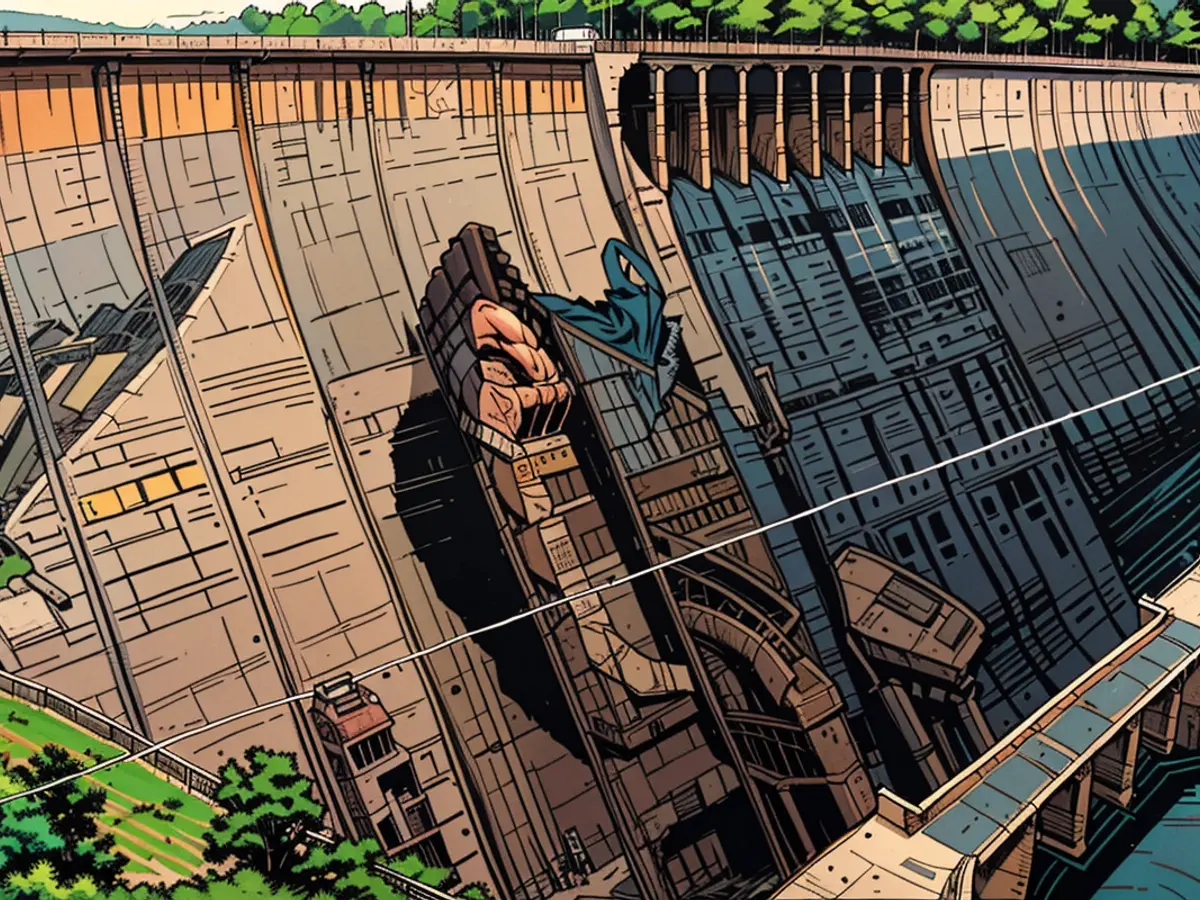Reverse graffiti in the Harz Mountains - Huge butterfly graffiti appear on dam wall
Artist Klaus Dauven holds a plan that looks like a template for "Painting by Numbers". There are 1,400 small dots on a small sheet indicating the outlines of wings. Dauven, 58 years old, stands with a chisel hat and sack on a several hundred meter long suspension bridge before the dam, which sways in the wind and rain. On the dam, his idea is slowly emerging: Eleven giant butterflies, sprayed with high-pressure cleaners by industrial climbers. This is his largest work in Germany.
The Rappbodetalsperre is the largest drinking water dam in Germany. The dam is 460 meters long and 75 meters high - and currently the canvas for Klaus Dauven's ideas. The artist from North Rhine-Westphalia is known for his large "Reverse Graffiti" that adorns dams in France and Japan. Reverse, because he doesn't add anything but removes the dirt from a surface and reveals his motifs. The Rappbodetalsperre is the seventh dam that Dauven uses as a canvas.
Motif with ecological message
"The idea starts on an A3 sized sheet," says Dauven. "Seeing how big it gets is always an experience." Hundreds of small dots were projected from the drawing onto the dam using a laser, shining bright yellow and pink. They guide the industrial climbers, who use high-pressure cleaners to draw the lines on the dam.
The motif is gradually recognizable: Butterflies. "The first time I was here at the dam, it was clear to me that the motif had something to do with flying," says Dauven. The dam is a tourist attraction. Bungee jumpers jump from the suspension bridge in front of it, tourists hang from a zip line for a minute over more than 450 meters in length into the depths - always at the water surface. Dauven finally decided on the butterfly species "Little Grebe": "The species is endemic to the Harz region. I wanted to give the dam some lightness." At the same time, it is an ecological message. Forest death also has effects on butterflies. The "Little Grebe" is on the Red List of endangered animal species in Saxony-Anhalt. A few kilometers from the Rappbodetalsperre in the Harz National Park, you can see what Dauven means: Climate change and pine beetles have caused large bald spots around the Brocken, the highest mountain in the region.
Four weeks of work for five to seven years durability
Artist Klaus Dauven has been working with the dam operator Sachsen-Anhalt for over a year and is preparing the project. Business manager Burkhard Henning hopes to attract more visitors to the Harz through the artwork. "It's unique. You can't see graffiti this close, with the suspension bridge in front, anywhere else."
Dauven does not paint himself. Four industrial climbers hang for up to eight hours a day on ropes at the dam. For them, the four weeks of work time is a challenge, explains project leader Nick Heyden from the company Kärcher, which sponsors the project. "Once it's gone, it won't come back." It must be exactly according to the template. The animals are not just drawn as lines, the entire dirt on the dam is removed. "You have to keep the peace."
Overall, it takes four weeks to paint butterflies on the dam. Five to seven years is what Dauven calculates, then they are likely to have disappeared again - fleeting, like nature itself.
Dauven's plan for the artwork includes 1,400 small dots, reminiscent of a "Painting by Numbers" template. The project, his largest in Germany, is being executed on the Rappbodetalsperre, a drinking water reservoir and Germany's largest dam. Klaus Dauven, an artist from North Rhine-Westphalia, is renowned for his large-scale "Reverse Graffiti" on dams in France and Japan. The motif for this project is butterflies, chosen to bring a sense of lightness to the dam and serve as an ecological message.
The butterfly species selected is the "Little Grebe," which is endemic to the Harz region and is currently endangered in Saxony-Anhalt. The process involves projecting small dots from a drawing onto the dam and having industrial climbers use high-pressure cleaners to draw lines. The entire dirt on the dam is removed for the creation of the animals, ensuring precision.
Dauven collaborates with the dam operator, Sachsen-Anhalt, with the aim of attracting more tourism. Local business manager, Burkhard Henning, sees potential in the unique piece of art. The work involves four industrial climbers who hang at the dam for up to eight hours a day, completing the project in four weeks.
The artwork is expected to have a lifespan of five to seven years, which Dauven calculates based on the eventual disappearance of the butterflies. The concept mirrors the fleeting nature of life and the environment itself. Dauven's artwork can be found on the lapel of his hat, symbolizing his dedication to his art and the environment.






